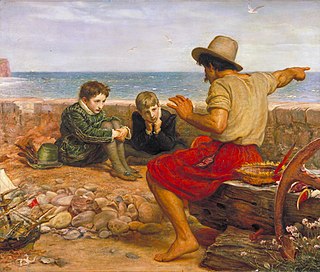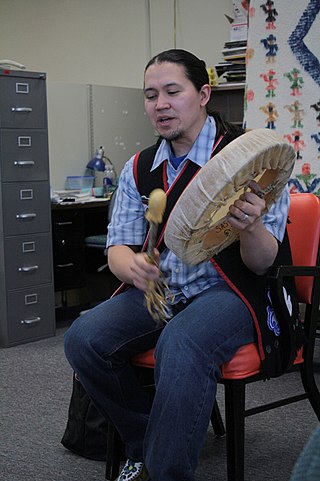
A first-person narrative is a mode of storytelling in which a storyteller recounts events from that storyteller's own personal point of view, using first-person grammar such as "I", "me", "my", and "myself". It must be narrated by a first-person character, such as a protagonist, re-teller, witness, or peripheral character. Alternatively, in a visual storytelling medium, the first-person perspective is a graphical perspective rendered through a character's visual field, so the camera is "seeing" out of a character's eyes.

Storytelling is the social and cultural activity of sharing stories, sometimes with improvisation, theatrics or embellishment. Every culture has its own narratives, which are shared as a means of entertainment, education, cultural preservation or instilling moral values. Crucial elements of stories and storytelling include plot, characters and narrative point of view. The term "storytelling" can refer specifically to oral storytelling but also broadly to techniques used in other media to unfold or disclose the narrative of a story.

A narrative, story, or tale is any account of a series of related events or experiences, whether non-fictional or fictional. Narratives can be presented through a sequence of written or spoken words, through still or moving images, or through any combination of these. The word derives from the Latin verb narrare, which is derived from the adjective gnarus. The formal and literary process of constructing a narrative—narration—is one of the four traditional rhetorical modes of discourse, along with argumentation, description, and exposition. This is a somewhat distinct usage from narration in the narrower sense of a commentary used to convey a story. Many additional narrative techniques, particularly literary ones, are used to build and enhance any given story.
Narration is the use of a written or spoken commentary to convey a story to an audience. Narration is conveyed by a narrator: a specific person, or unspecified literary voice, developed by the creator of the story to deliver information to the audience, particularly about the plot: the series of events. Narration is a required element of all written stories, presenting the story in its entirety. It is optional in most other storytelling formats, such as films, plays, television shows and video games, in which the story can be conveyed through other means, like dialogue between characters or visual action.
In contemporary literary studies, a theme is a central topic, subject, or message within a narrative. Themes can be divided into two categories: a work's thematic concept is what readers "think the work is about" and its thematic statement being "what the work says about the subject". Themes are often distinguished from premises.
Biblical hermeneutics is the study of the principles of interpretation concerning the books of the Bible. It is part of the broader field of hermeneutics, which involves the study of principles of interpretation, both theory and methodology, for all forms of communication, nonverbal and verbal. While Jewish and Christian biblical hermeneutics have some overlap and dialogue, they have distinctly separate interpretative traditions.
Narrative journalism, also referred to as literary journalism, is defined as creative nonfiction that contains accurate, well-researched information. It is related to immersion journalism, where a writer follows a subject or theme for a long period of time and details an individual's experiences from a deeply personal perspective.
Ethel Barrett was a Christian writer, speaker and storyteller, whose popularity peaked between the early 1950s and the mid-1980s. She sold millions of copies of over 40 different books for publishers like Zondervan, Gospel Light and Regal Books. The latter printed and sold more than four million copies of her work. She also performed on 30 audio records and tapes.
Transmedia storytelling is the technique of telling a single story or story experience across multiple platforms and formats using current digital technologies.
A Fabel is a critical analysis of the plot of a play. It is a dramaturgical technique that was pioneered by Bertolt Brecht, a 20th century German theatre practitioner.
The following outline is provided as an overview of and topical guide to acting:

Museum theatre is the use of theatre and theatrical techniques by a museum for educational, informative, and entertainment purposes. It can also be used in a zoo, an aquarium, an art gallery, and at historic sites. It is generally performed by professional actors. Varieties of museum theatre include historical characters, puppetry, movement and music.

Oral storytelling is an ancient and intimate tradition between the storyteller and their audience. The storyteller and the listeners are physically close, often seated together in a circular fashion. The intimacy and connection are deepened by the flexibility of oral storytelling which allows the tale to be molded according to the needs of the audience and the location or environment of the telling. Listeners also experience the urgency of a creative process taking place in their presence and they experience the empowerment of being a part of that creative process. Storytelling creates a personal bond with the teller and the audience.
American Sign Language literature is one of the most important shared cultural experiences in the American deaf community. Literary genres initially developed in residential Deaf institutes, such as American School for the Deaf in Hartford, Connecticut, which is where American Sign Language developed as a language in the early 19th century. There are many genres of ASL literature, such as narratives of personal experience, poetry, cinematographic stories, folktales, translated works, original fiction and stories with handshape constraints. Authors of ASL literature use their body as the text of their work, which is visually read and comprehended by their audience viewers. In the early development of ASL literary genres, the works were generally not analyzed as written texts are, but the increased dissemination of ASL literature on video has led to greater analysis of these genres.

Alaska Native storytelling has been passed down through generations by means of oral presentation. The stories tell life lessons or serve as lessons in heritage. Many different aspects of Arctic life are incorporated into each story, mainly the various animals found in Alaska. Due to the decline in the number of speakers of native languages in Alaska and a change in lifestyle amongst many of the native peoples, oral storytelling has become less common. In recent years many of these stories have been written down, though many people argue that the telling of the story is just as important as the words within.
Telling Stories with Tomie dePaola is a 2001 children's television series produced by The Jim Henson Company.

Pingtan, also known as Suzhou Pingtan, is a regional variant of quyi and a popular musical/oral performance art form in the Jiangnan region of China, encompassing southern Jiangsu, northern Zhejiang, and Shanghai. Originating from Suzhou, it is a blend of the Chinese narrative musical traditions of pinghua and tanci, with roots tracing back to the Song dynasty and influences from Wuyue culture.
Personal narrative (PN) is a prose narrative relating personal experience usually told in first person; its content is nontraditional. "Personal" refers to a story from one's life or experiences. "Nontraditional" refers to literature that does not fit the typical criteria of a narrative.
In literature, pace or pacing is the speed at which a story is told—not necessarily the speed at which the story takes place. It is an essential element of storytelling that plays a significant role in maintaining reader interest, building tension, and conveying the desired emotional impact. The number of words needed to write about a certain event does not depend upon how much time the event takes to happen; it depends upon how important that moment is to the story. The pace is determined by the length of the scenes, how fast the action moves, and how quickly the reader is provided with information. A well-paced story effectively balances moments of high intensity and slower-paced sections to create a dynamic reading experience. It is also sometimes dictated by the genre of the story: comedies move faster than dramas; action adventures move faster than suspense. A dragging pace is characteristic of many novels turned down by publishers, and of some that find their way into print but not into the hearts and recommendations of readers. Manuscripts that move too slowly usually discourage readers from reading on. Through various editing techniques, such as cutting unnecessary details, rearranging scenes, or suggesting additions, editors assist in maintaining an engaging pace that keeps readers captivated. Yanna Popova and Elena Cuffari elaborate that as editors they, "explore the participatory structure of a narrative through its temporal unfolding and the specific, non-linear nature of the temporal dynamics of interacting with a storytelling agency". Popova and Cuffari make clear that the way an author unfolds a story through structuring that narrative's tale is essential to the way the audience will interpret it.
Inspired by the biological classification system of the Linnaean taxonomy, screenwriter Eric R. Williams developed the Screenwriters Taxonomy in 2017 to create a common language of creative collaboration for filmmakers. Williams’ central thesis in The Screenwriters Taxonomy: A Roadmap to Collaborative Storytelling is that the term “genre” is used so broadly to describe films that the modern use of the word has become meaningless. The Screenwriter's Taxonomy proposes seven categories for discussing the creative process of telling cinematic stories.
- Type
- Super Genre
- Macrogenres
- Microgenres
- Voice
- Pathway
- Point of View









